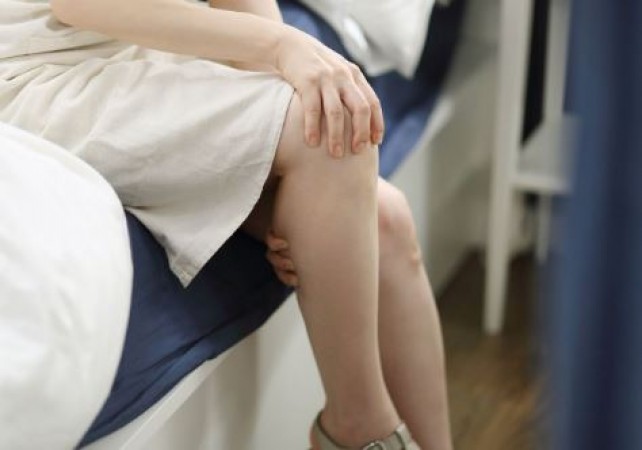
Premenstrual symptoms can be a rollercoaster ride, affecting not just mood but also physical health. One of the lesser-known but equally bothersome symptoms is the onset of leg pain and discomfort before menstruation begins. In this article, we will delve into the reasons behind this phenomenon and explore insights from medical professionals.
The Menstrual Cycle: A Rollercoaster of Hormonal Changes
The menstrual cycle is a complex interplay of hormones and physiological processes that prepare the body for potential pregnancy each month. Estrogen and progesterone, two key hormones, fluctuate throughout the cycle, orchestrating changes in the uterus, ovaries, and other reproductive organs.
Estrogen levels rise in the first half of the cycle, stimulating the growth of the uterine lining. Meanwhile, progesterone levels increase after ovulation, preparing the uterus for implantation and maintaining the pregnancy if conception occurs. These hormonal shifts not only regulate the menstrual cycle but also influence mood, energy levels, and pain perception.
Pre-Menstrual Syndrome (PMS) and Its Impact
Pre-menstrual syndrome (PMS) encompasses a broad range of physical and emotional symptoms that typically occur in the days leading up to menstruation. While the severity and duration of symptoms can vary among individuals, common manifestations include bloating, breast tenderness, mood swings, and abdominal discomfort.
The exact cause of PMS is not fully understood, but hormonal fluctuations, neurotransmitter imbalances, and lifestyle factors are believed to play a role. For some individuals, PMS can significantly impact daily functioning and quality of life, making it essential to explore effective management strategies.
Understanding Leg and Waist Pain Before Periods
While abdominal cramps are a well-known symptom of menstruation, some individuals also experience pain and discomfort in their legs and waist during this time. This phenomenon, known as menstrual-related leg and waist pain, is less widely recognized but can be equally distressing for those affected.
The mechanisms underlying menstrual-related leg and waist pain are not fully understood. However, researchers believe that hormonal fluctuations, particularly changes in prostaglandin levels, may contribute to increased sensitivity to pain and discomfort in various parts of the body.
Prostaglandins are hormone-like substances involved in inflammation and pain signaling. During menstruation, the uterus produces higher levels of prostaglandins to promote uterine contractions and facilitate the shedding of the uterine lining. These elevated prostaglandin levels may not only trigger menstrual cramps but also affect other areas of the body, leading to referred pain in the legs and waist.
Expert Insights: What Doctors Say
Medical professionals acknowledge the phenomenon of menstrual-related leg and waist pain but note that more research is needed to fully understand its underlying mechanisms. While hormonal fluctuations are believed to play a role, individual differences in pain perception and sensitivity may also contribute to variability in symptoms.
According to experts, managing menstrual-related leg and waist pain often involves a combination of lifestyle modifications and targeted interventions. Over-the-counter pain relievers, such as nonsteroidal anti-inflammatory drugs (NSAIDs), can help alleviate discomfort by reducing inflammation and blocking pain signals.
In addition to pharmacological treatments, heat therapy, regular exercise, and stress management techniques may also provide relief from premenstrual symptoms. By adopting a holistic approach to menstrual health, individuals can empower themselves to manage discomfort and improve their overall well-being.
Managing Leg and Waist Pain Associated with Menstruation
While menstrual-related leg and waist pain can be bothersome, there are several strategies that individuals can employ to alleviate discomfort and improve their quality of life:
Over-the-counter Pain Relievers: Nonsteroidal anti-inflammatory drugs (NSAIDs), such as ibuprofen or naproxen, can help reduce inflammation and alleviate menstrual cramps and associated leg and waist pain. These medications work by inhibiting the production of prostaglandins, thereby reducing uterine contractions and easing discomfort.
Heat Therapy: Applying a heating pad or taking a warm bath can soothe muscles and increase blood flow to the affected areas, relieving tension and reducing pain. Heat therapy is particularly effective for menstrual-related leg and waist pain, as it helps relax muscles and alleviate cramping.
Regular Exercise: Engaging in regular physical activity throughout the menstrual cycle can help alleviate symptoms of PMS and promote overall well-being. Exercise releases endorphins, natural painkillers that can help reduce menstrual cramps and improve mood.
Healthy Lifestyle Choices: Adopting a healthy lifestyle can have a significant impact on menstrual health and well-being. Eating a balanced diet rich in fruits, vegetables, whole grains, and lean proteins can help regulate hormone levels and reduce inflammation. Staying hydrated, getting an adequate amount of sleep, and managing stress through relaxation techniques, such as deep breathing or meditation, can also contribute to symptom relief.
Alternative Therapies: Some individuals find relief from menstrual-related symptoms through alternative therapies, such as acupuncture, acupressure, or herbal remedies. While the scientific evidence supporting these treatments may be limited, many people report subjective improvements in pain and overall well-being.
Consultation with Healthcare Providers: If menstrual-related leg and waist pain persist or significantly impact daily functioning, it's essential to consult with a healthcare provider for further evaluation and management. A healthcare provider can assess individual symptoms, rule out underlying medical conditions, and recommend appropriate treatment options tailored to the individual's needs.
Seeking Relief for Menstrual-Related Discomfort
Menstrual-related leg and waist pain can be challenging to manage, but by understanding the underlying mechanisms and implementing targeted interventions, individuals can find relief and improve their quality of life. Whether through over-the-counter pain relievers, heat therapy, regular exercise, or healthy lifestyle choices, there are various strategies available to alleviate discomfort and promote menstrual health. By taking a proactive approach to menstrual health and seeking support from healthcare providers when needed, individuals can empower themselves to navigate the ups and downs of the menstrual cycle with greater ease and comfort.
How to Make Alia Bhatt's Favorite Salad for Radiant Health, Weight Management, and More!
Shilpa Shetty Slays in Mugler Masterpiece! Black Gown Takes the Internet by Storm
Bollywood Singer Anuradha Paudwal Joins BJP Ahead of Elections